AMSC700 Case Study: Samsung's Supply Chain and Logistics Optimization
VerifiedAdded on 2022/11/07
|13
|3253
|443
Report
AI Summary
This report examines Samsung's supply chain and logistics management, focusing on how the company can reduce costs and increase its competitive advantage. It provides an overview of Samsung's organizational and industry background, followed by an analysis of operations and performance management, including supply chain drivers. The report explores integration considerations and value generation, including a Value Stream Map (VSM) and concludes with recommendations for improved efficiency and productivity. Key aspects discussed include distributors, suppliers, and logistics strategies, along with internal and external integration. The report also explores how Samsung leverages its supply chain to maintain a competitive edge in the global electronics market. The report is a contribution to Desklib, a platform providing AI-based study tools for students.
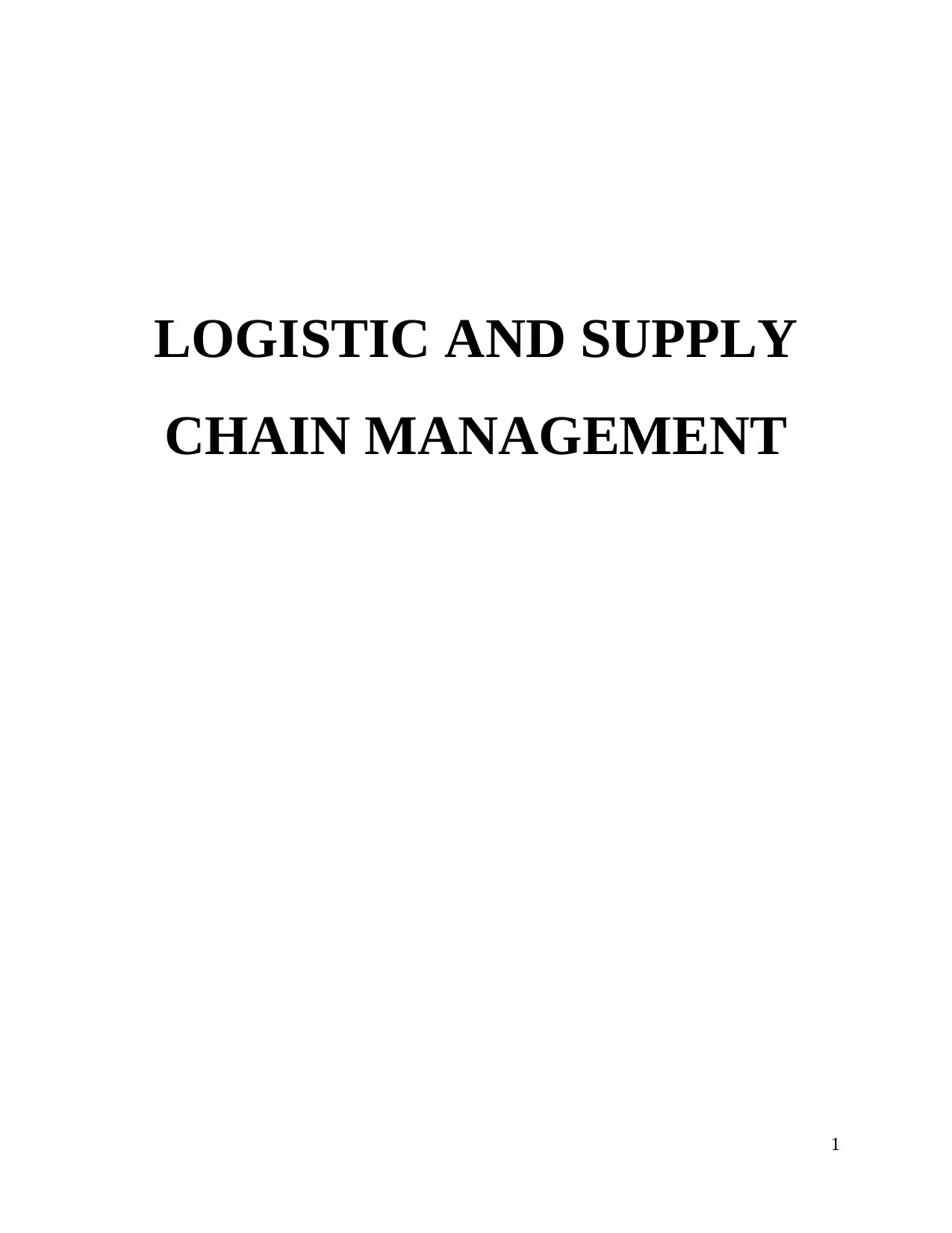
LOGISTIC AND SUPPLY
CHAIN MANAGEMENT
1
CHAIN MANAGEMENT
1
Paraphrase This Document
Need a fresh take? Get an instant paraphrase of this document with our AI Paraphraser
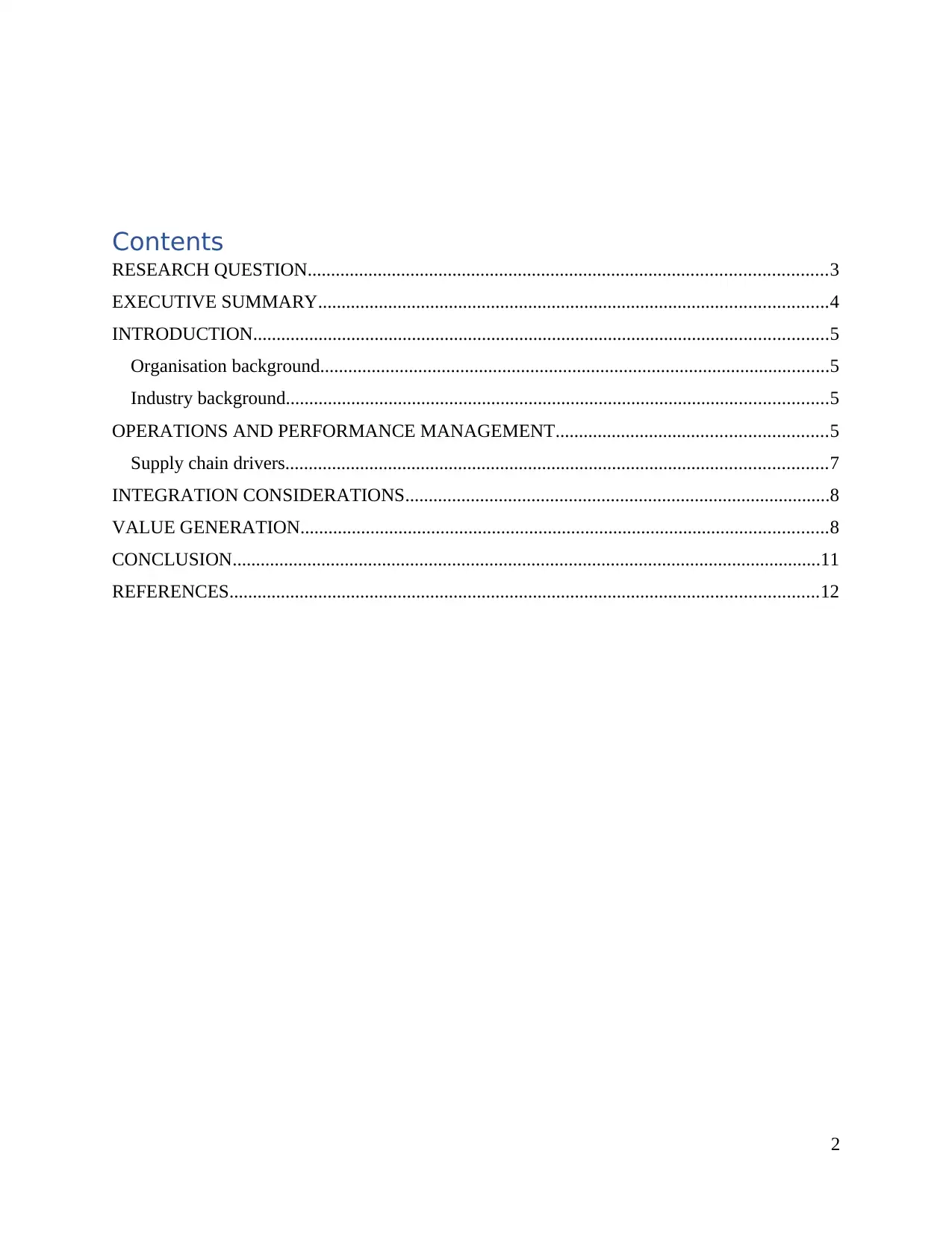
Contents
RESEARCH QUESTION...............................................................................................................3
EXECUTIVE SUMMARY.............................................................................................................4
INTRODUCTION...........................................................................................................................5
Organisation background.............................................................................................................5
Industry background....................................................................................................................5
OPERATIONS AND PERFORMANCE MANAGEMENT..........................................................5
Supply chain drivers....................................................................................................................7
INTEGRATION CONSIDERATIONS...........................................................................................8
VALUE GENERATION.................................................................................................................8
CONCLUSION..............................................................................................................................11
REFERENCES..............................................................................................................................12
2
RESEARCH QUESTION...............................................................................................................3
EXECUTIVE SUMMARY.............................................................................................................4
INTRODUCTION...........................................................................................................................5
Organisation background.............................................................................................................5
Industry background....................................................................................................................5
OPERATIONS AND PERFORMANCE MANAGEMENT..........................................................5
Supply chain drivers....................................................................................................................7
INTEGRATION CONSIDERATIONS...........................................................................................8
VALUE GENERATION.................................................................................................................8
CONCLUSION..............................................................................................................................11
REFERENCES..............................................................................................................................12
2
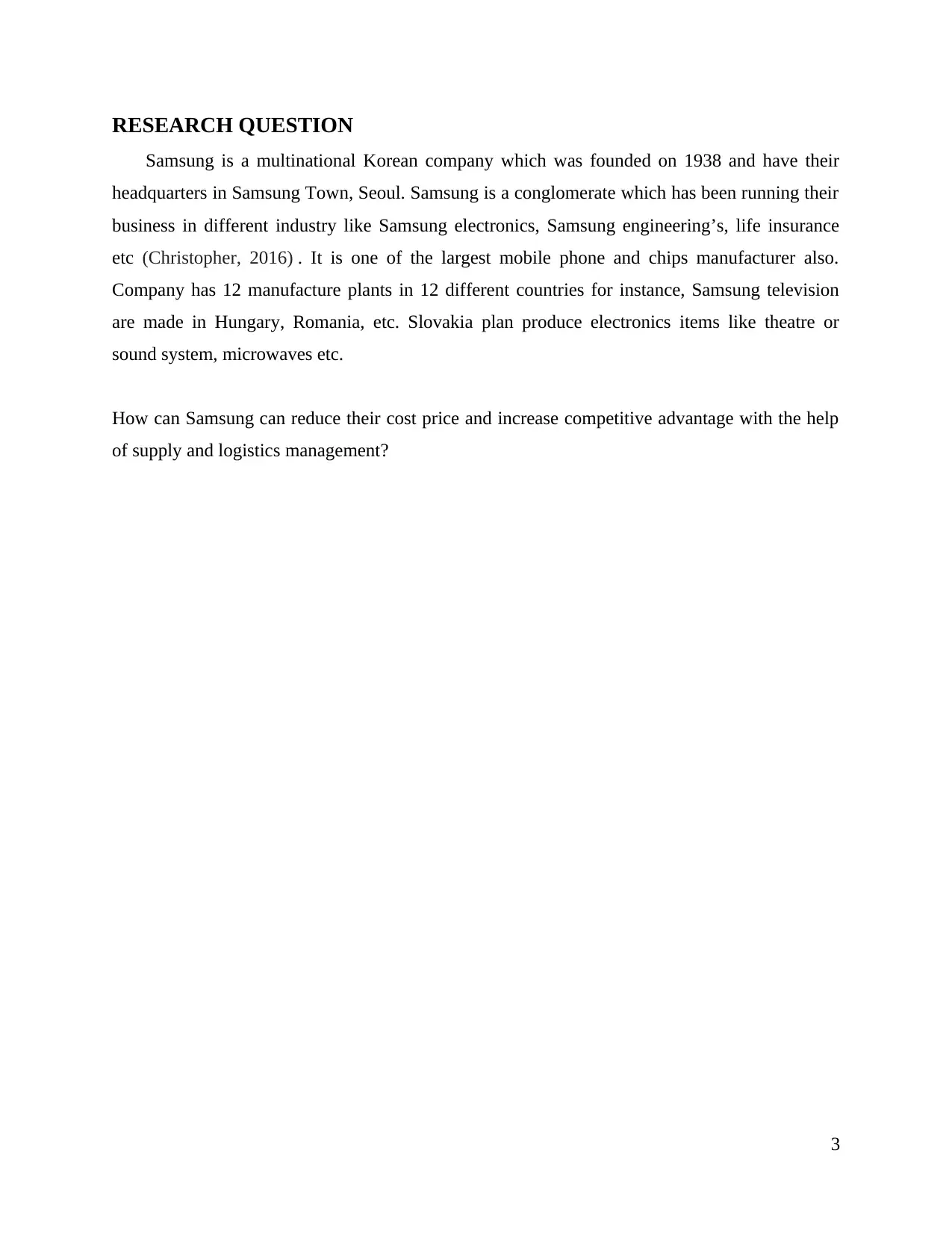
RESEARCH QUESTION
Samsung is a multinational Korean company which was founded on 1938 and have their
headquarters in Samsung Town, Seoul. Samsung is a conglomerate which has been running their
business in different industry like Samsung electronics, Samsung engineering’s, life insurance
etc (Christopher, 2016) . It is one of the largest mobile phone and chips manufacturer also.
Company has 12 manufacture plants in 12 different countries for instance, Samsung television
are made in Hungary, Romania, etc. Slovakia plan produce electronics items like theatre or
sound system, microwaves etc.
How can Samsung can reduce their cost price and increase competitive advantage with the help
of supply and logistics management?
3
Samsung is a multinational Korean company which was founded on 1938 and have their
headquarters in Samsung Town, Seoul. Samsung is a conglomerate which has been running their
business in different industry like Samsung electronics, Samsung engineering’s, life insurance
etc (Christopher, 2016) . It is one of the largest mobile phone and chips manufacturer also.
Company has 12 manufacture plants in 12 different countries for instance, Samsung television
are made in Hungary, Romania, etc. Slovakia plan produce electronics items like theatre or
sound system, microwaves etc.
How can Samsung can reduce their cost price and increase competitive advantage with the help
of supply and logistics management?
3
⊘ This is a preview!⊘
Do you want full access?
Subscribe today to unlock all pages.

Trusted by 1+ million students worldwide
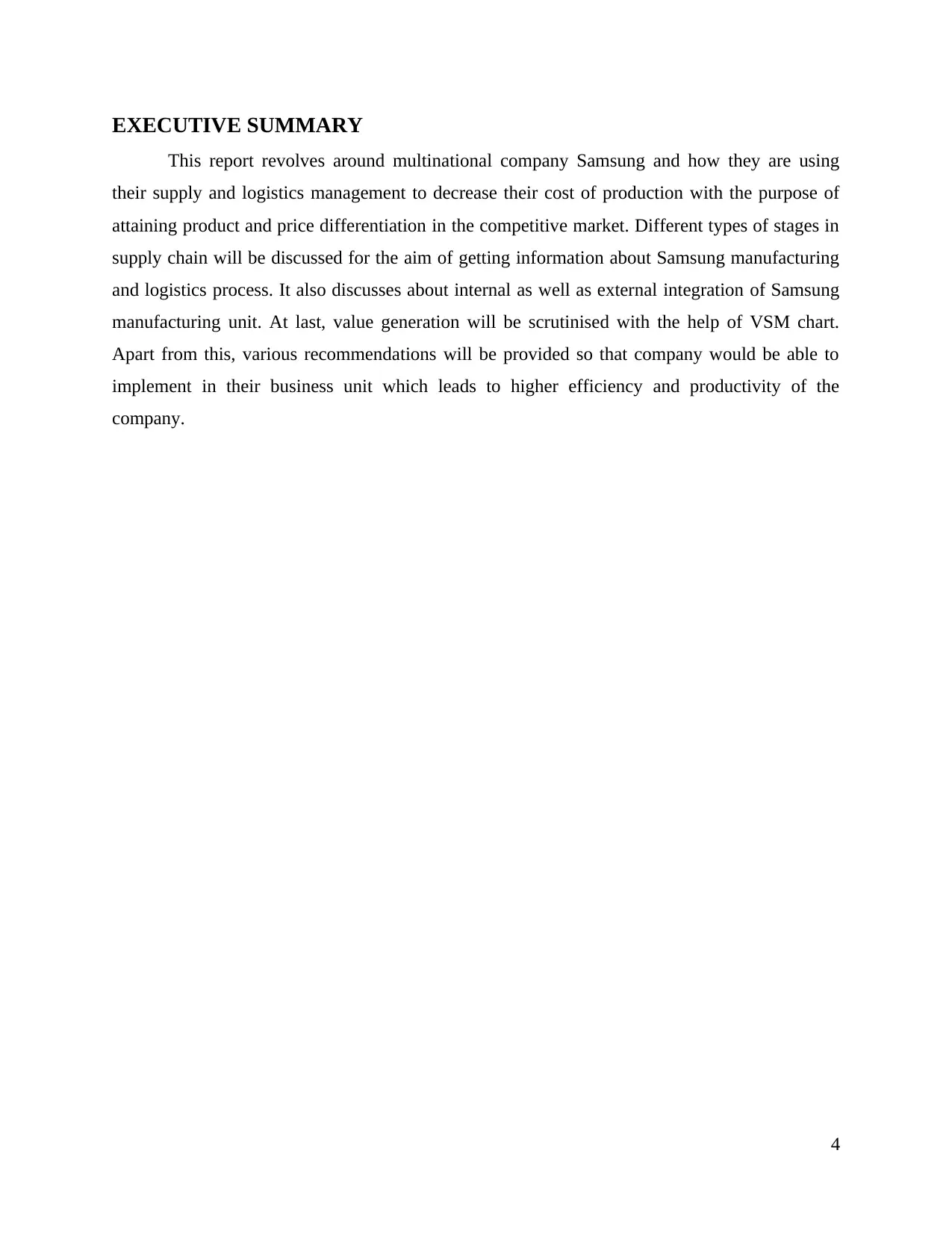
EXECUTIVE SUMMARY
This report revolves around multinational company Samsung and how they are using
their supply and logistics management to decrease their cost of production with the purpose of
attaining product and price differentiation in the competitive market. Different types of stages in
supply chain will be discussed for the aim of getting information about Samsung manufacturing
and logistics process. It also discusses about internal as well as external integration of Samsung
manufacturing unit. At last, value generation will be scrutinised with the help of VSM chart.
Apart from this, various recommendations will be provided so that company would be able to
implement in their business unit which leads to higher efficiency and productivity of the
company.
4
This report revolves around multinational company Samsung and how they are using
their supply and logistics management to decrease their cost of production with the purpose of
attaining product and price differentiation in the competitive market. Different types of stages in
supply chain will be discussed for the aim of getting information about Samsung manufacturing
and logistics process. It also discusses about internal as well as external integration of Samsung
manufacturing unit. At last, value generation will be scrutinised with the help of VSM chart.
Apart from this, various recommendations will be provided so that company would be able to
implement in their business unit which leads to higher efficiency and productivity of the
company.
4
Paraphrase This Document
Need a fresh take? Get an instant paraphrase of this document with our AI Paraphraser
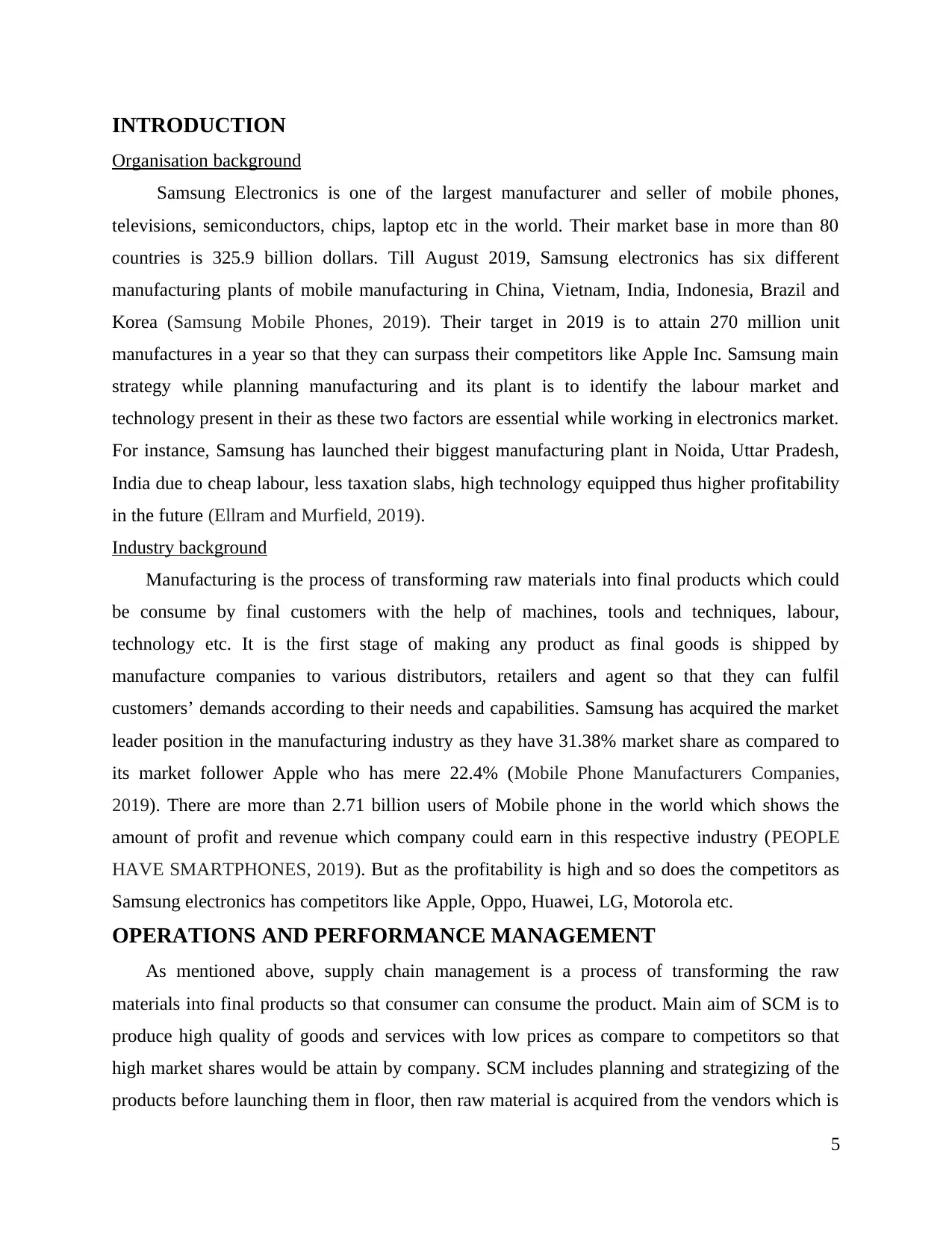
INTRODUCTION
Organisation background
Samsung Electronics is one of the largest manufacturer and seller of mobile phones,
televisions, semiconductors, chips, laptop etc in the world. Their market base in more than 80
countries is 325.9 billion dollars. Till August 2019, Samsung electronics has six different
manufacturing plants of mobile manufacturing in China, Vietnam, India, Indonesia, Brazil and
Korea (Samsung Mobile Phones, 2019). Their target in 2019 is to attain 270 million unit
manufactures in a year so that they can surpass their competitors like Apple Inc. Samsung main
strategy while planning manufacturing and its plant is to identify the labour market and
technology present in their as these two factors are essential while working in electronics market.
For instance, Samsung has launched their biggest manufacturing plant in Noida, Uttar Pradesh,
India due to cheap labour, less taxation slabs, high technology equipped thus higher profitability
in the future (Ellram and Murfield, 2019).
Industry background
Manufacturing is the process of transforming raw materials into final products which could
be consume by final customers with the help of machines, tools and techniques, labour,
technology etc. It is the first stage of making any product as final goods is shipped by
manufacture companies to various distributors, retailers and agent so that they can fulfil
customers’ demands according to their needs and capabilities. Samsung has acquired the market
leader position in the manufacturing industry as they have 31.38% market share as compared to
its market follower Apple who has mere 22.4% (Mobile Phone Manufacturers Companies,
2019). There are more than 2.71 billion users of Mobile phone in the world which shows the
amount of profit and revenue which company could earn in this respective industry (PEOPLE
HAVE SMARTPHONES, 2019). But as the profitability is high and so does the competitors as
Samsung electronics has competitors like Apple, Oppo, Huawei, LG, Motorola etc.
OPERATIONS AND PERFORMANCE MANAGEMENT
As mentioned above, supply chain management is a process of transforming the raw
materials into final products so that consumer can consume the product. Main aim of SCM is to
produce high quality of goods and services with low prices as compare to competitors so that
high market shares would be attain by company. SCM includes planning and strategizing of the
products before launching them in floor, then raw material is acquired from the vendors which is
5
Organisation background
Samsung Electronics is one of the largest manufacturer and seller of mobile phones,
televisions, semiconductors, chips, laptop etc in the world. Their market base in more than 80
countries is 325.9 billion dollars. Till August 2019, Samsung electronics has six different
manufacturing plants of mobile manufacturing in China, Vietnam, India, Indonesia, Brazil and
Korea (Samsung Mobile Phones, 2019). Their target in 2019 is to attain 270 million unit
manufactures in a year so that they can surpass their competitors like Apple Inc. Samsung main
strategy while planning manufacturing and its plant is to identify the labour market and
technology present in their as these two factors are essential while working in electronics market.
For instance, Samsung has launched their biggest manufacturing plant in Noida, Uttar Pradesh,
India due to cheap labour, less taxation slabs, high technology equipped thus higher profitability
in the future (Ellram and Murfield, 2019).
Industry background
Manufacturing is the process of transforming raw materials into final products which could
be consume by final customers with the help of machines, tools and techniques, labour,
technology etc. It is the first stage of making any product as final goods is shipped by
manufacture companies to various distributors, retailers and agent so that they can fulfil
customers’ demands according to their needs and capabilities. Samsung has acquired the market
leader position in the manufacturing industry as they have 31.38% market share as compared to
its market follower Apple who has mere 22.4% (Mobile Phone Manufacturers Companies,
2019). There are more than 2.71 billion users of Mobile phone in the world which shows the
amount of profit and revenue which company could earn in this respective industry (PEOPLE
HAVE SMARTPHONES, 2019). But as the profitability is high and so does the competitors as
Samsung electronics has competitors like Apple, Oppo, Huawei, LG, Motorola etc.
OPERATIONS AND PERFORMANCE MANAGEMENT
As mentioned above, supply chain management is a process of transforming the raw
materials into final products so that consumer can consume the product. Main aim of SCM is to
produce high quality of goods and services with low prices as compare to competitors so that
high market shares would be attain by company. SCM includes planning and strategizing of the
products before launching them in floor, then raw material is acquired from the vendors which is
5
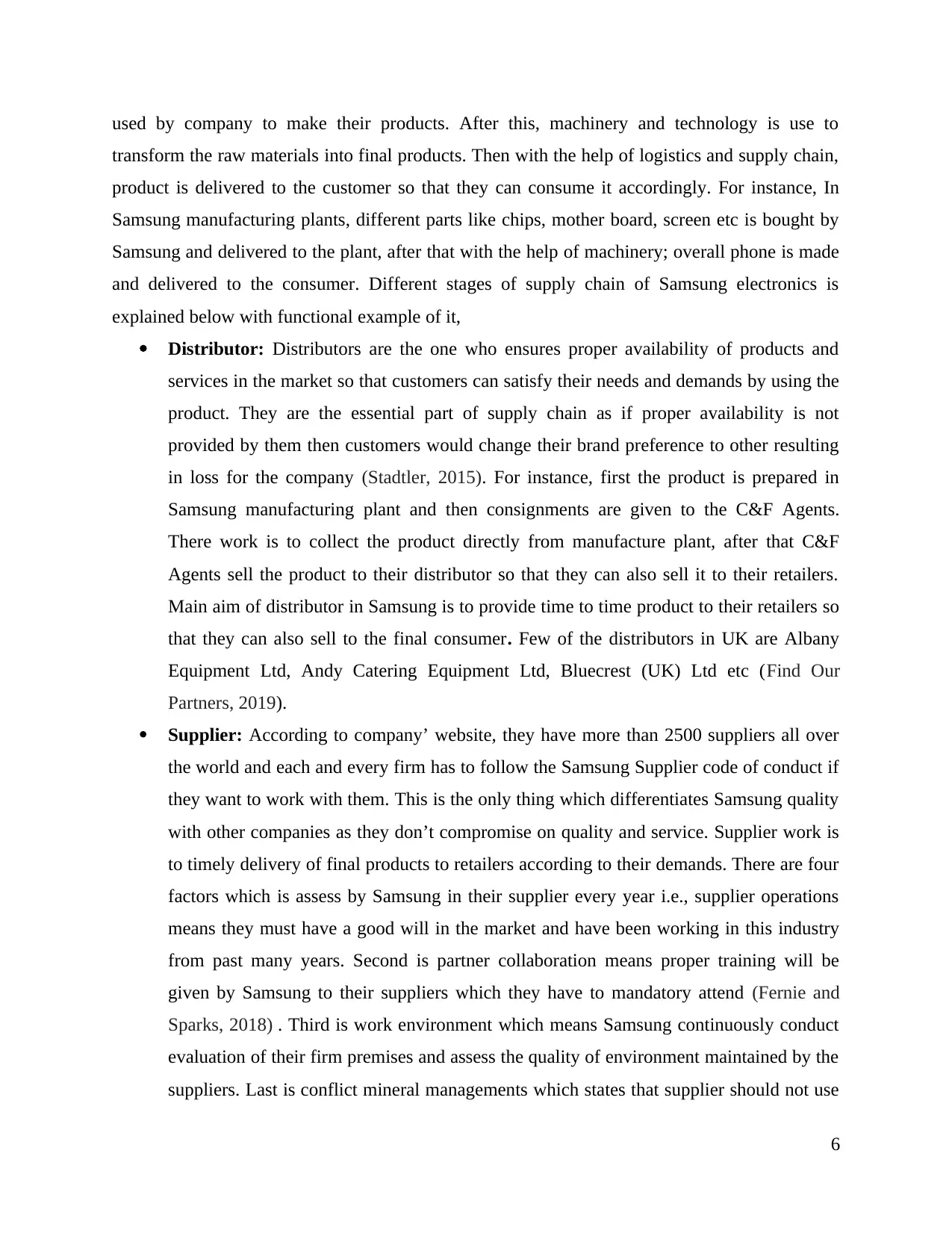
used by company to make their products. After this, machinery and technology is use to
transform the raw materials into final products. Then with the help of logistics and supply chain,
product is delivered to the customer so that they can consume it accordingly. For instance, In
Samsung manufacturing plants, different parts like chips, mother board, screen etc is bought by
Samsung and delivered to the plant, after that with the help of machinery; overall phone is made
and delivered to the consumer. Different stages of supply chain of Samsung electronics is
explained below with functional example of it,
Distributor: Distributors are the one who ensures proper availability of products and
services in the market so that customers can satisfy their needs and demands by using the
product. They are the essential part of supply chain as if proper availability is not
provided by them then customers would change their brand preference to other resulting
in loss for the company (Stadtler, 2015). For instance, first the product is prepared in
Samsung manufacturing plant and then consignments are given to the C&F Agents.
There work is to collect the product directly from manufacture plant, after that C&F
Agents sell the product to their distributor so that they can also sell it to their retailers.
Main aim of distributor in Samsung is to provide time to time product to their retailers so
that they can also sell to the final consumer. Few of the distributors in UK are Albany
Equipment Ltd, Andy Catering Equipment Ltd, Bluecrest (UK) Ltd etc (Find Our
Partners, 2019).
Supplier: According to company’ website, they have more than 2500 suppliers all over
the world and each and every firm has to follow the Samsung Supplier code of conduct if
they want to work with them. This is the only thing which differentiates Samsung quality
with other companies as they don’t compromise on quality and service. Supplier work is
to timely delivery of final products to retailers according to their demands. There are four
factors which is assess by Samsung in their supplier every year i.e., supplier operations
means they must have a good will in the market and have been working in this industry
from past many years. Second is partner collaboration means proper training will be
given by Samsung to their suppliers which they have to mandatory attend (Fernie and
Sparks, 2018) . Third is work environment which means Samsung continuously conduct
evaluation of their firm premises and assess the quality of environment maintained by the
suppliers. Last is conflict mineral managements which states that supplier should not use
6
transform the raw materials into final products. Then with the help of logistics and supply chain,
product is delivered to the customer so that they can consume it accordingly. For instance, In
Samsung manufacturing plants, different parts like chips, mother board, screen etc is bought by
Samsung and delivered to the plant, after that with the help of machinery; overall phone is made
and delivered to the consumer. Different stages of supply chain of Samsung electronics is
explained below with functional example of it,
Distributor: Distributors are the one who ensures proper availability of products and
services in the market so that customers can satisfy their needs and demands by using the
product. They are the essential part of supply chain as if proper availability is not
provided by them then customers would change their brand preference to other resulting
in loss for the company (Stadtler, 2015). For instance, first the product is prepared in
Samsung manufacturing plant and then consignments are given to the C&F Agents.
There work is to collect the product directly from manufacture plant, after that C&F
Agents sell the product to their distributor so that they can also sell it to their retailers.
Main aim of distributor in Samsung is to provide time to time product to their retailers so
that they can also sell to the final consumer. Few of the distributors in UK are Albany
Equipment Ltd, Andy Catering Equipment Ltd, Bluecrest (UK) Ltd etc (Find Our
Partners, 2019).
Supplier: According to company’ website, they have more than 2500 suppliers all over
the world and each and every firm has to follow the Samsung Supplier code of conduct if
they want to work with them. This is the only thing which differentiates Samsung quality
with other companies as they don’t compromise on quality and service. Supplier work is
to timely delivery of final products to retailers according to their demands. There are four
factors which is assess by Samsung in their supplier every year i.e., supplier operations
means they must have a good will in the market and have been working in this industry
from past many years. Second is partner collaboration means proper training will be
given by Samsung to their suppliers which they have to mandatory attend (Fernie and
Sparks, 2018) . Third is work environment which means Samsung continuously conduct
evaluation of their firm premises and assess the quality of environment maintained by the
suppliers. Last is conflict mineral managements which states that supplier should not use
6
⊘ This is a preview!⊘
Do you want full access?
Subscribe today to unlock all pages.

Trusted by 1+ million students worldwide
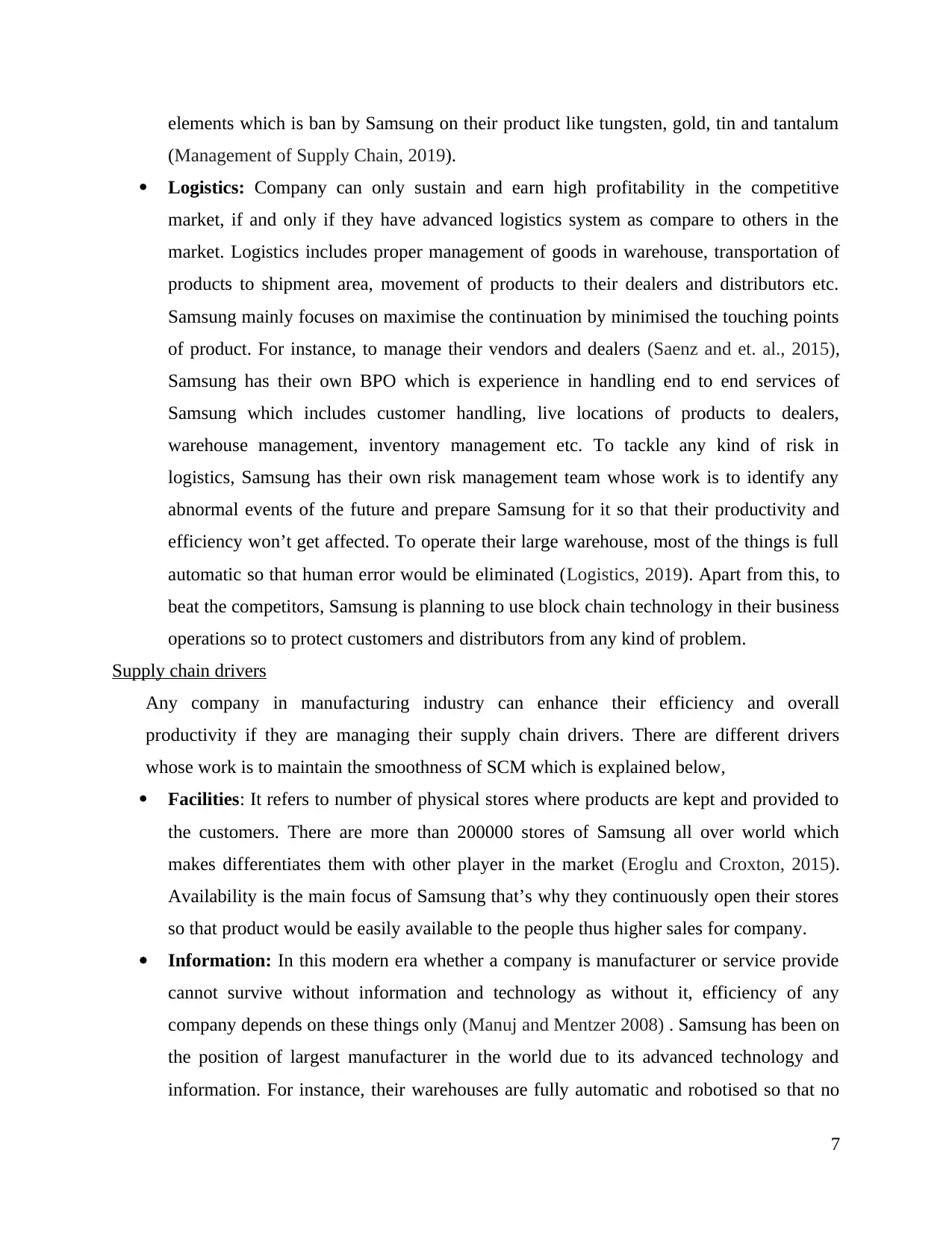
elements which is ban by Samsung on their product like tungsten, gold, tin and tantalum
(Management of Supply Chain, 2019).
Logistics: Company can only sustain and earn high profitability in the competitive
market, if and only if they have advanced logistics system as compare to others in the
market. Logistics includes proper management of goods in warehouse, transportation of
products to shipment area, movement of products to their dealers and distributors etc.
Samsung mainly focuses on maximise the continuation by minimised the touching points
of product. For instance, to manage their vendors and dealers (Saenz and et. al., 2015),
Samsung has their own BPO which is experience in handling end to end services of
Samsung which includes customer handling, live locations of products to dealers,
warehouse management, inventory management etc. To tackle any kind of risk in
logistics, Samsung has their own risk management team whose work is to identify any
abnormal events of the future and prepare Samsung for it so that their productivity and
efficiency won’t get affected. To operate their large warehouse, most of the things is full
automatic so that human error would be eliminated (Logistics, 2019). Apart from this, to
beat the competitors, Samsung is planning to use block chain technology in their business
operations so to protect customers and distributors from any kind of problem.
Supply chain drivers
Any company in manufacturing industry can enhance their efficiency and overall
productivity if they are managing their supply chain drivers. There are different drivers
whose work is to maintain the smoothness of SCM which is explained below,
Facilities: It refers to number of physical stores where products are kept and provided to
the customers. There are more than 200000 stores of Samsung all over world which
makes differentiates them with other player in the market (Eroglu and Croxton, 2015).
Availability is the main focus of Samsung that’s why they continuously open their stores
so that product would be easily available to the people thus higher sales for company.
Information: In this modern era whether a company is manufacturer or service provide
cannot survive without information and technology as without it, efficiency of any
company depends on these things only (Manuj and Mentzer 2008) . Samsung has been on
the position of largest manufacturer in the world due to its advanced technology and
information. For instance, their warehouses are fully automatic and robotised so that no
7
(Management of Supply Chain, 2019).
Logistics: Company can only sustain and earn high profitability in the competitive
market, if and only if they have advanced logistics system as compare to others in the
market. Logistics includes proper management of goods in warehouse, transportation of
products to shipment area, movement of products to their dealers and distributors etc.
Samsung mainly focuses on maximise the continuation by minimised the touching points
of product. For instance, to manage their vendors and dealers (Saenz and et. al., 2015),
Samsung has their own BPO which is experience in handling end to end services of
Samsung which includes customer handling, live locations of products to dealers,
warehouse management, inventory management etc. To tackle any kind of risk in
logistics, Samsung has their own risk management team whose work is to identify any
abnormal events of the future and prepare Samsung for it so that their productivity and
efficiency won’t get affected. To operate their large warehouse, most of the things is full
automatic so that human error would be eliminated (Logistics, 2019). Apart from this, to
beat the competitors, Samsung is planning to use block chain technology in their business
operations so to protect customers and distributors from any kind of problem.
Supply chain drivers
Any company in manufacturing industry can enhance their efficiency and overall
productivity if they are managing their supply chain drivers. There are different drivers
whose work is to maintain the smoothness of SCM which is explained below,
Facilities: It refers to number of physical stores where products are kept and provided to
the customers. There are more than 200000 stores of Samsung all over world which
makes differentiates them with other player in the market (Eroglu and Croxton, 2015).
Availability is the main focus of Samsung that’s why they continuously open their stores
so that product would be easily available to the people thus higher sales for company.
Information: In this modern era whether a company is manufacturer or service provide
cannot survive without information and technology as without it, efficiency of any
company depends on these things only (Manuj and Mentzer 2008) . Samsung has been on
the position of largest manufacturer in the world due to its advanced technology and
information. For instance, their warehouses are fully automatic and robotised so that no
7
Paraphrase This Document
Need a fresh take? Get an instant paraphrase of this document with our AI Paraphraser
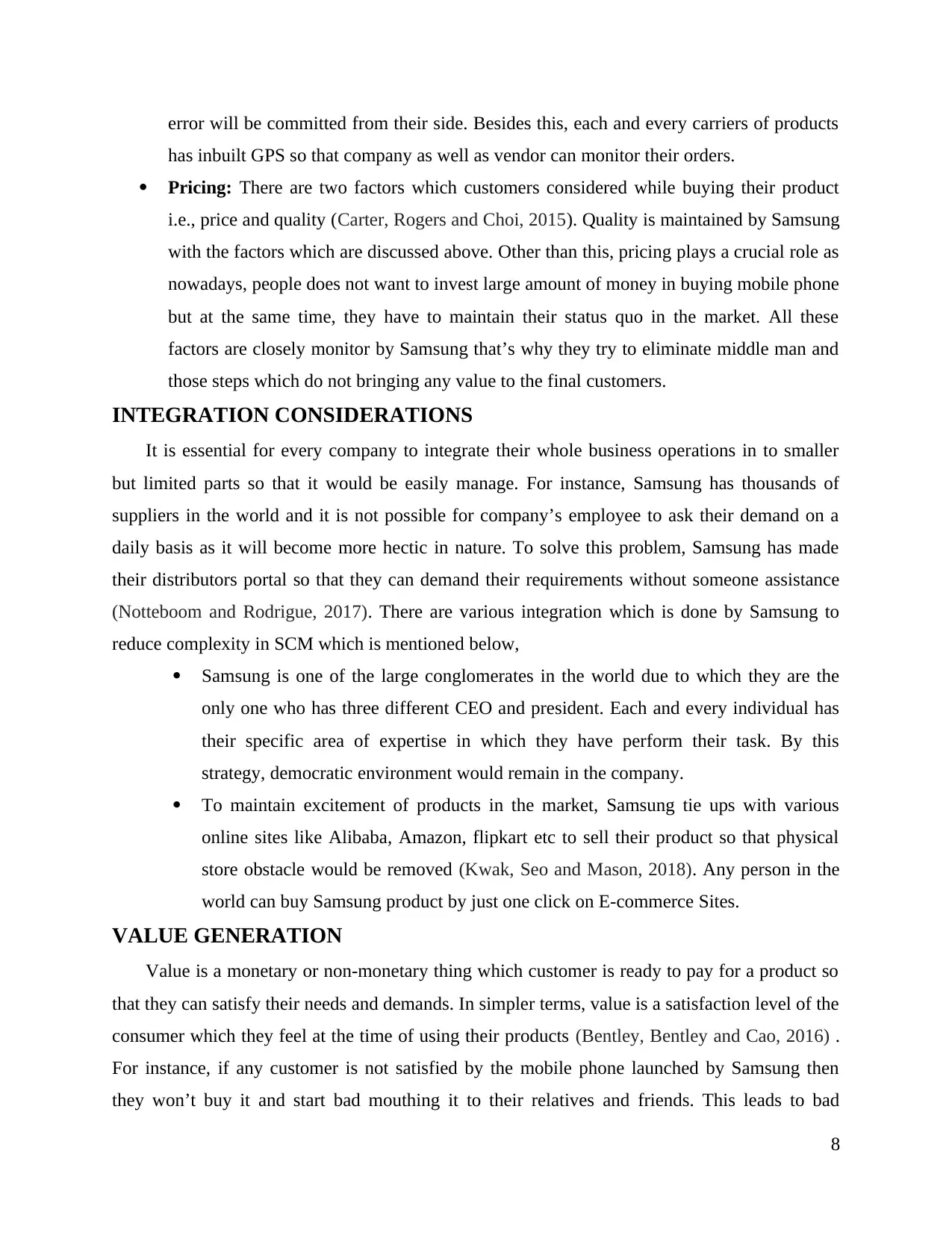
error will be committed from their side. Besides this, each and every carriers of products
has inbuilt GPS so that company as well as vendor can monitor their orders.
Pricing: There are two factors which customers considered while buying their product
i.e., price and quality (Carter, Rogers and Choi, 2015). Quality is maintained by Samsung
with the factors which are discussed above. Other than this, pricing plays a crucial role as
nowadays, people does not want to invest large amount of money in buying mobile phone
but at the same time, they have to maintain their status quo in the market. All these
factors are closely monitor by Samsung that’s why they try to eliminate middle man and
those steps which do not bringing any value to the final customers.
INTEGRATION CONSIDERATIONS
It is essential for every company to integrate their whole business operations in to smaller
but limited parts so that it would be easily manage. For instance, Samsung has thousands of
suppliers in the world and it is not possible for company’s employee to ask their demand on a
daily basis as it will become more hectic in nature. To solve this problem, Samsung has made
their distributors portal so that they can demand their requirements without someone assistance
(Notteboom and Rodrigue, 2017). There are various integration which is done by Samsung to
reduce complexity in SCM which is mentioned below,
Samsung is one of the large conglomerates in the world due to which they are the
only one who has three different CEO and president. Each and every individual has
their specific area of expertise in which they have perform their task. By this
strategy, democratic environment would remain in the company.
To maintain excitement of products in the market, Samsung tie ups with various
online sites like Alibaba, Amazon, flipkart etc to sell their product so that physical
store obstacle would be removed (Kwak, Seo and Mason, 2018). Any person in the
world can buy Samsung product by just one click on E-commerce Sites.
VALUE GENERATION
Value is a monetary or non-monetary thing which customer is ready to pay for a product so
that they can satisfy their needs and demands. In simpler terms, value is a satisfaction level of the
consumer which they feel at the time of using their products (Bentley, Bentley and Cao, 2016) .
For instance, if any customer is not satisfied by the mobile phone launched by Samsung then
they won’t buy it and start bad mouthing it to their relatives and friends. This leads to bad
8
has inbuilt GPS so that company as well as vendor can monitor their orders.
Pricing: There are two factors which customers considered while buying their product
i.e., price and quality (Carter, Rogers and Choi, 2015). Quality is maintained by Samsung
with the factors which are discussed above. Other than this, pricing plays a crucial role as
nowadays, people does not want to invest large amount of money in buying mobile phone
but at the same time, they have to maintain their status quo in the market. All these
factors are closely monitor by Samsung that’s why they try to eliminate middle man and
those steps which do not bringing any value to the final customers.
INTEGRATION CONSIDERATIONS
It is essential for every company to integrate their whole business operations in to smaller
but limited parts so that it would be easily manage. For instance, Samsung has thousands of
suppliers in the world and it is not possible for company’s employee to ask their demand on a
daily basis as it will become more hectic in nature. To solve this problem, Samsung has made
their distributors portal so that they can demand their requirements without someone assistance
(Notteboom and Rodrigue, 2017). There are various integration which is done by Samsung to
reduce complexity in SCM which is mentioned below,
Samsung is one of the large conglomerates in the world due to which they are the
only one who has three different CEO and president. Each and every individual has
their specific area of expertise in which they have perform their task. By this
strategy, democratic environment would remain in the company.
To maintain excitement of products in the market, Samsung tie ups with various
online sites like Alibaba, Amazon, flipkart etc to sell their product so that physical
store obstacle would be removed (Kwak, Seo and Mason, 2018). Any person in the
world can buy Samsung product by just one click on E-commerce Sites.
VALUE GENERATION
Value is a monetary or non-monetary thing which customer is ready to pay for a product so
that they can satisfy their needs and demands. In simpler terms, value is a satisfaction level of the
consumer which they feel at the time of using their products (Bentley, Bentley and Cao, 2016) .
For instance, if any customer is not satisfied by the mobile phone launched by Samsung then
they won’t buy it and start bad mouthing it to their relatives and friends. This leads to bad
8
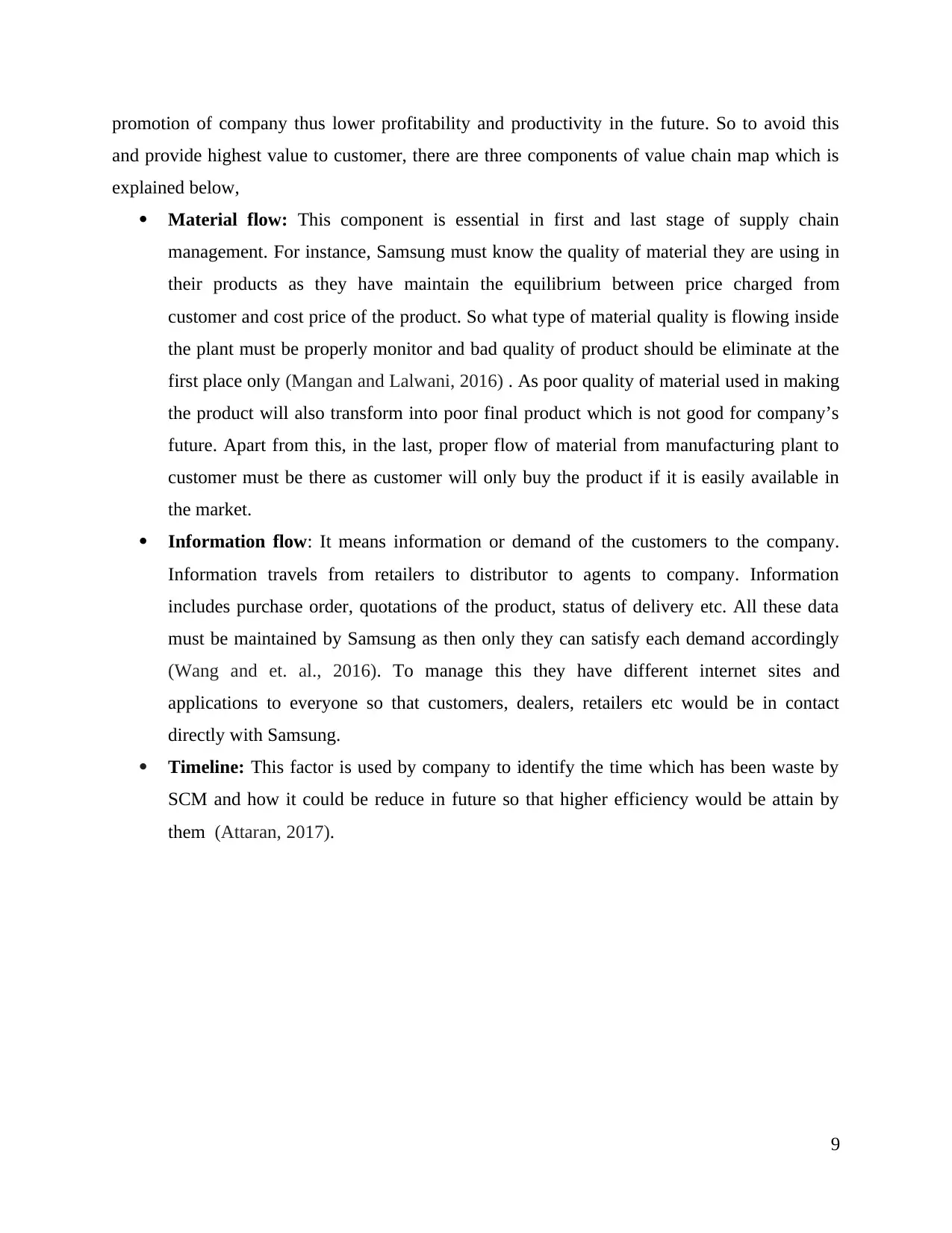
promotion of company thus lower profitability and productivity in the future. So to avoid this
and provide highest value to customer, there are three components of value chain map which is
explained below,
Material flow: This component is essential in first and last stage of supply chain
management. For instance, Samsung must know the quality of material they are using in
their products as they have maintain the equilibrium between price charged from
customer and cost price of the product. So what type of material quality is flowing inside
the plant must be properly monitor and bad quality of product should be eliminate at the
first place only (Mangan and Lalwani, 2016) . As poor quality of material used in making
the product will also transform into poor final product which is not good for company’s
future. Apart from this, in the last, proper flow of material from manufacturing plant to
customer must be there as customer will only buy the product if it is easily available in
the market.
Information flow: It means information or demand of the customers to the company.
Information travels from retailers to distributor to agents to company. Information
includes purchase order, quotations of the product, status of delivery etc. All these data
must be maintained by Samsung as then only they can satisfy each demand accordingly
(Wang and et. al., 2016). To manage this they have different internet sites and
applications to everyone so that customers, dealers, retailers etc would be in contact
directly with Samsung.
Timeline: This factor is used by company to identify the time which has been waste by
SCM and how it could be reduce in future so that higher efficiency would be attain by
them (Attaran, 2017).
9
and provide highest value to customer, there are three components of value chain map which is
explained below,
Material flow: This component is essential in first and last stage of supply chain
management. For instance, Samsung must know the quality of material they are using in
their products as they have maintain the equilibrium between price charged from
customer and cost price of the product. So what type of material quality is flowing inside
the plant must be properly monitor and bad quality of product should be eliminate at the
first place only (Mangan and Lalwani, 2016) . As poor quality of material used in making
the product will also transform into poor final product which is not good for company’s
future. Apart from this, in the last, proper flow of material from manufacturing plant to
customer must be there as customer will only buy the product if it is easily available in
the market.
Information flow: It means information or demand of the customers to the company.
Information travels from retailers to distributor to agents to company. Information
includes purchase order, quotations of the product, status of delivery etc. All these data
must be maintained by Samsung as then only they can satisfy each demand accordingly
(Wang and et. al., 2016). To manage this they have different internet sites and
applications to everyone so that customers, dealers, retailers etc would be in contact
directly with Samsung.
Timeline: This factor is used by company to identify the time which has been waste by
SCM and how it could be reduce in future so that higher efficiency would be attain by
them (Attaran, 2017).
9
⊘ This is a preview!⊘
Do you want full access?
Subscribe today to unlock all pages.

Trusted by 1+ million students worldwide
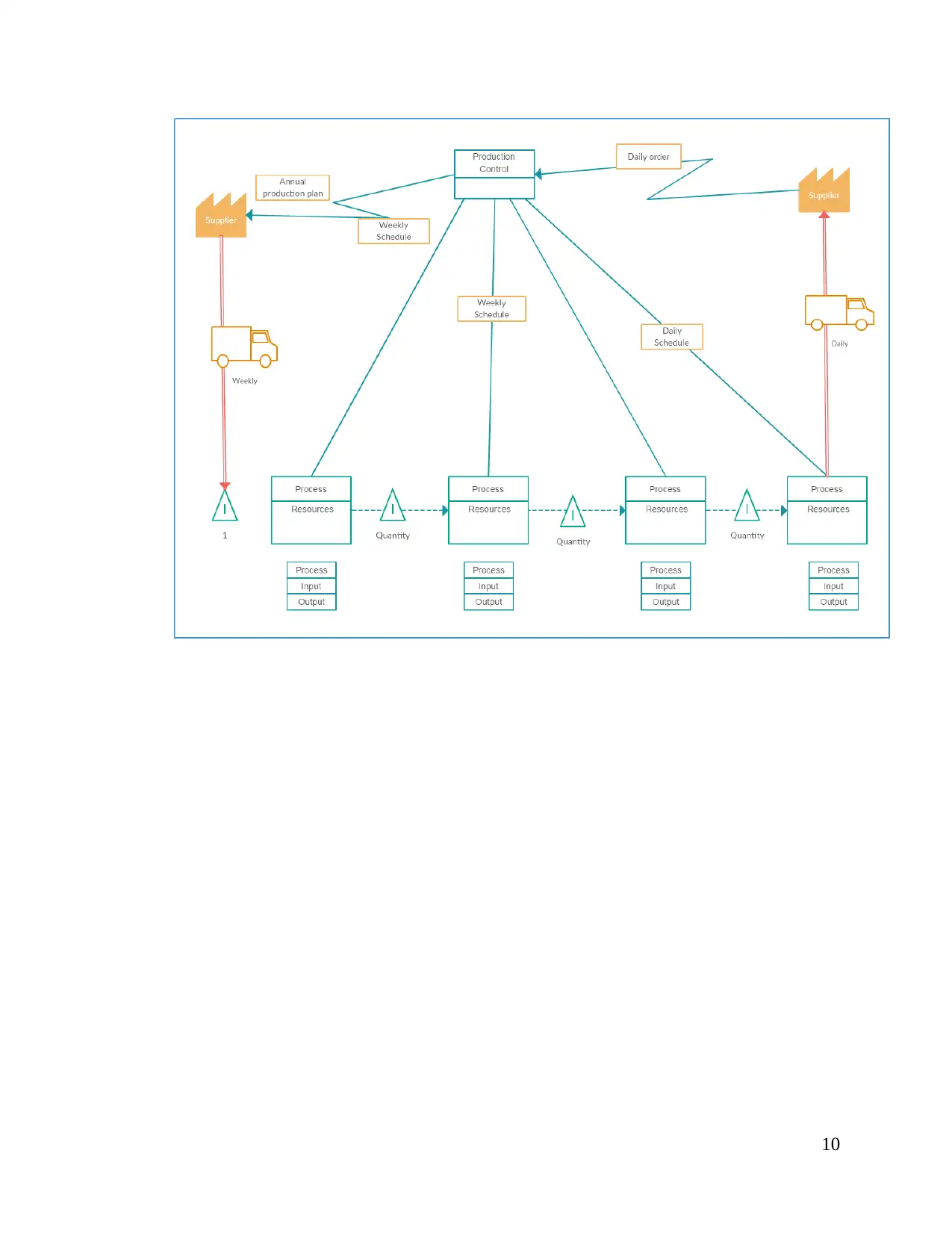
10
Paraphrase This Document
Need a fresh take? Get an instant paraphrase of this document with our AI Paraphraser
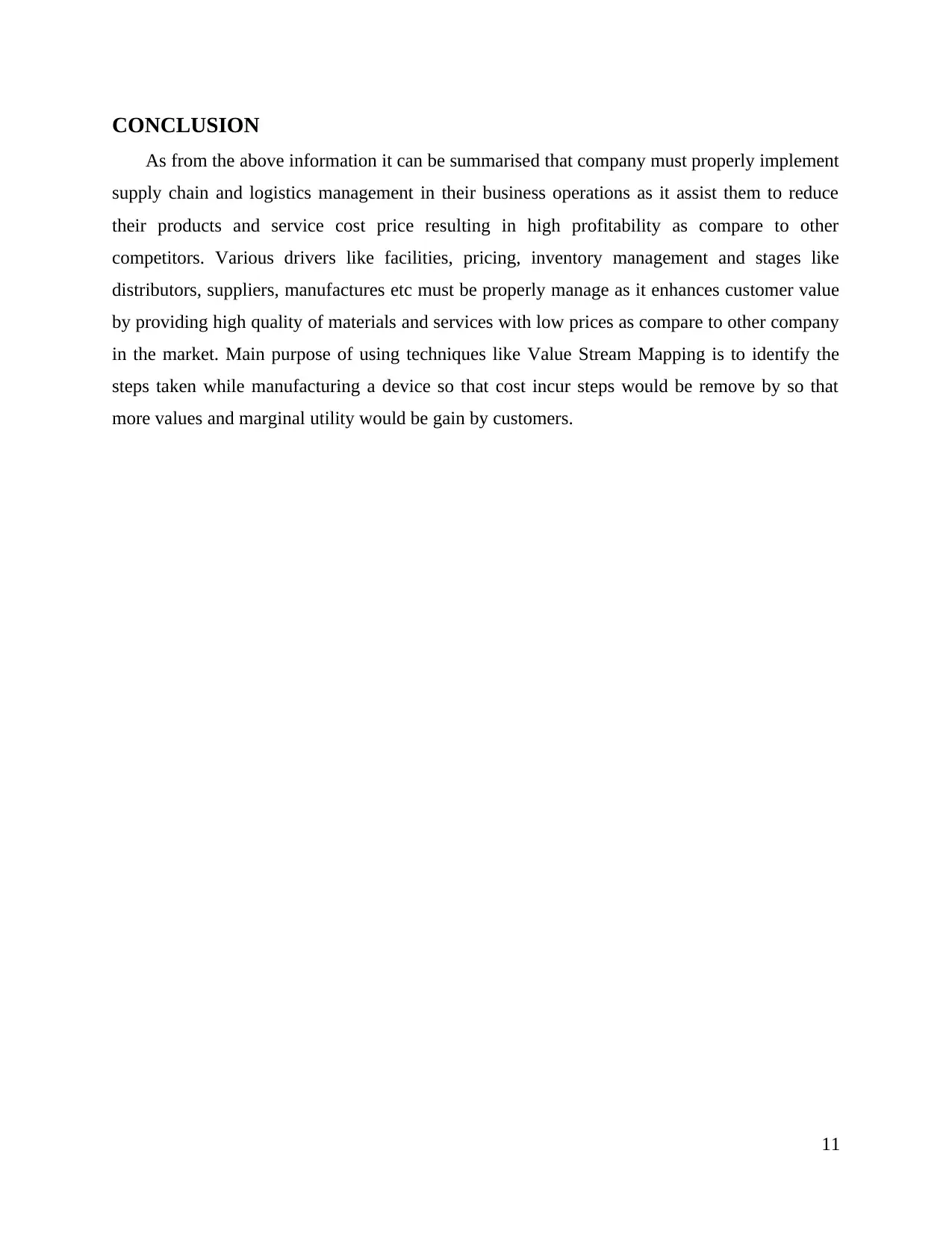
CONCLUSION
As from the above information it can be summarised that company must properly implement
supply chain and logistics management in their business operations as it assist them to reduce
their products and service cost price resulting in high profitability as compare to other
competitors. Various drivers like facilities, pricing, inventory management and stages like
distributors, suppliers, manufactures etc must be properly manage as it enhances customer value
by providing high quality of materials and services with low prices as compare to other company
in the market. Main purpose of using techniques like Value Stream Mapping is to identify the
steps taken while manufacturing a device so that cost incur steps would be remove by so that
more values and marginal utility would be gain by customers.
11
As from the above information it can be summarised that company must properly implement
supply chain and logistics management in their business operations as it assist them to reduce
their products and service cost price resulting in high profitability as compare to other
competitors. Various drivers like facilities, pricing, inventory management and stages like
distributors, suppliers, manufactures etc must be properly manage as it enhances customer value
by providing high quality of materials and services with low prices as compare to other company
in the market. Main purpose of using techniques like Value Stream Mapping is to identify the
steps taken while manufacturing a device so that cost incur steps would be remove by so that
more values and marginal utility would be gain by customers.
11
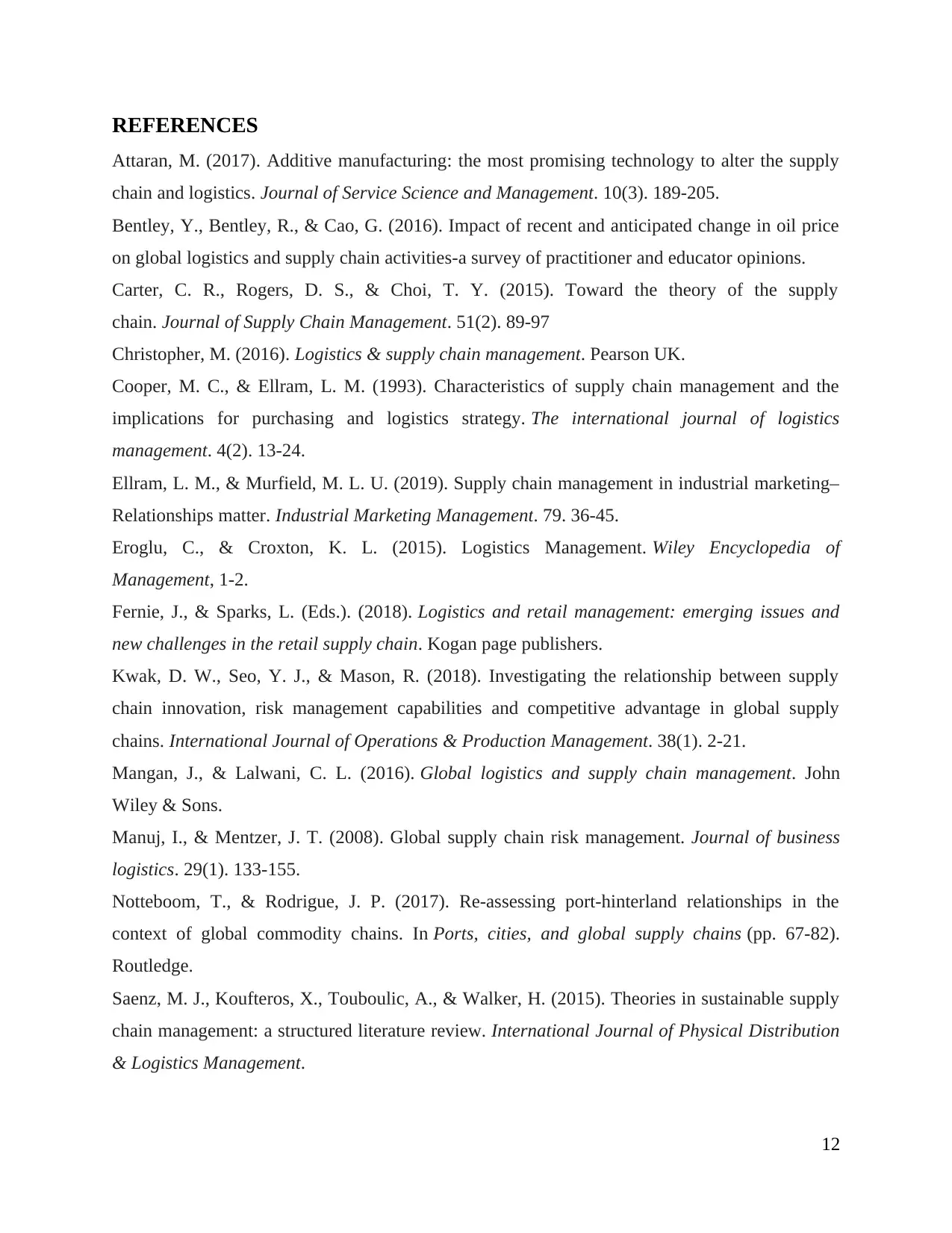
REFERENCES
Attaran, M. (2017). Additive manufacturing: the most promising technology to alter the supply
chain and logistics. Journal of Service Science and Management. 10(3). 189-205.
Bentley, Y., Bentley, R., & Cao, G. (2016). Impact of recent and anticipated change in oil price
on global logistics and supply chain activities-a survey of practitioner and educator opinions.
Carter, C. R., Rogers, D. S., & Choi, T. Y. (2015). Toward the theory of the supply
chain. Journal of Supply Chain Management. 51(2). 89-97
Christopher, M. (2016). Logistics & supply chain management. Pearson UK.
Cooper, M. C., & Ellram, L. M. (1993). Characteristics of supply chain management and the
implications for purchasing and logistics strategy. The international journal of logistics
management. 4(2). 13-24.
Ellram, L. M., & Murfield, M. L. U. (2019). Supply chain management in industrial marketing–
Relationships matter. Industrial Marketing Management. 79. 36-45.
Eroglu, C., & Croxton, K. L. (2015). Logistics Management. Wiley Encyclopedia of
Management, 1-2.
Fernie, J., & Sparks, L. (Eds.). (2018). Logistics and retail management: emerging issues and
new challenges in the retail supply chain. Kogan page publishers.
Kwak, D. W., Seo, Y. J., & Mason, R. (2018). Investigating the relationship between supply
chain innovation, risk management capabilities and competitive advantage in global supply
chains. International Journal of Operations & Production Management. 38(1). 2-21.
Mangan, J., & Lalwani, C. L. (2016). Global logistics and supply chain management. John
Wiley & Sons.
Manuj, I., & Mentzer, J. T. (2008). Global supply chain risk management. Journal of business
logistics. 29(1). 133-155.
Notteboom, T., & Rodrigue, J. P. (2017). Re-assessing port-hinterland relationships in the
context of global commodity chains. In Ports, cities, and global supply chains (pp. 67-82).
Routledge.
Saenz, M. J., Koufteros, X., Touboulic, A., & Walker, H. (2015). Theories in sustainable supply
chain management: a structured literature review. International Journal of Physical Distribution
& Logistics Management.
12
Attaran, M. (2017). Additive manufacturing: the most promising technology to alter the supply
chain and logistics. Journal of Service Science and Management. 10(3). 189-205.
Bentley, Y., Bentley, R., & Cao, G. (2016). Impact of recent and anticipated change in oil price
on global logistics and supply chain activities-a survey of practitioner and educator opinions.
Carter, C. R., Rogers, D. S., & Choi, T. Y. (2015). Toward the theory of the supply
chain. Journal of Supply Chain Management. 51(2). 89-97
Christopher, M. (2016). Logistics & supply chain management. Pearson UK.
Cooper, M. C., & Ellram, L. M. (1993). Characteristics of supply chain management and the
implications for purchasing and logistics strategy. The international journal of logistics
management. 4(2). 13-24.
Ellram, L. M., & Murfield, M. L. U. (2019). Supply chain management in industrial marketing–
Relationships matter. Industrial Marketing Management. 79. 36-45.
Eroglu, C., & Croxton, K. L. (2015). Logistics Management. Wiley Encyclopedia of
Management, 1-2.
Fernie, J., & Sparks, L. (Eds.). (2018). Logistics and retail management: emerging issues and
new challenges in the retail supply chain. Kogan page publishers.
Kwak, D. W., Seo, Y. J., & Mason, R. (2018). Investigating the relationship between supply
chain innovation, risk management capabilities and competitive advantage in global supply
chains. International Journal of Operations & Production Management. 38(1). 2-21.
Mangan, J., & Lalwani, C. L. (2016). Global logistics and supply chain management. John
Wiley & Sons.
Manuj, I., & Mentzer, J. T. (2008). Global supply chain risk management. Journal of business
logistics. 29(1). 133-155.
Notteboom, T., & Rodrigue, J. P. (2017). Re-assessing port-hinterland relationships in the
context of global commodity chains. In Ports, cities, and global supply chains (pp. 67-82).
Routledge.
Saenz, M. J., Koufteros, X., Touboulic, A., & Walker, H. (2015). Theories in sustainable supply
chain management: a structured literature review. International Journal of Physical Distribution
& Logistics Management.
12
⊘ This is a preview!⊘
Do you want full access?
Subscribe today to unlock all pages.

Trusted by 1+ million students worldwide
1 out of 13
Related Documents
Your All-in-One AI-Powered Toolkit for Academic Success.
+13062052269
info@desklib.com
Available 24*7 on WhatsApp / Email
![[object Object]](/_next/static/media/star-bottom.7253800d.svg)
Unlock your academic potential
Copyright © 2020–2025 A2Z Services. All Rights Reserved. Developed and managed by ZUCOL.





